What is a meta model?
What is a meta model?
A meta model is a description of a classification of a set of things.
It describes the types of thing (object types), the rules between them (relationships) and the attributes that describe them.
Meta models can usually be built to describe any type of problem or scenario.
They are often graphical and are represented by boxes and lines. Boxes indicate the object types and lines represent the relationships.
Meta models are used by end users to express models.
In the meta model example below, we could describe the relationship between a Pilot, Airline and Aircraft.
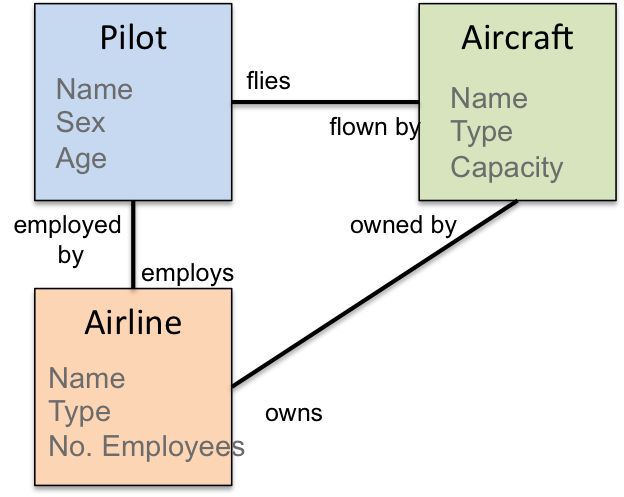
In the model below, we use the metamodel to guide the construction of the model. The meta model provides the framework within which the model can be constructed.
We call the instances of the object types - Objects.
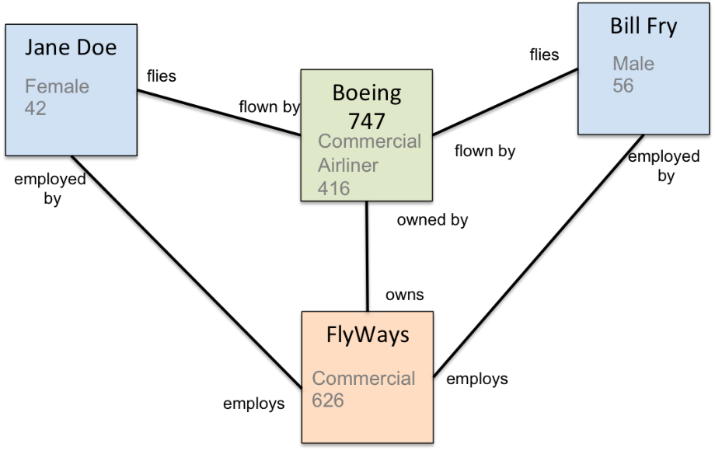
Meta models and the SPP
Each package in the erwin Data Foundation Platform has a meta model. The meta model can be changed. Further guidance is provided here.
The entire erwin Data Foundation Platform is a meta model in its own right. Each package is a subset of the entire meta model and some object types and relationships overlap.
Innovation management metamodel
Innovation management metamodel
Package: Innovation Management
Role Applicable to: Client Administrator, User, Contributor, Reviewer
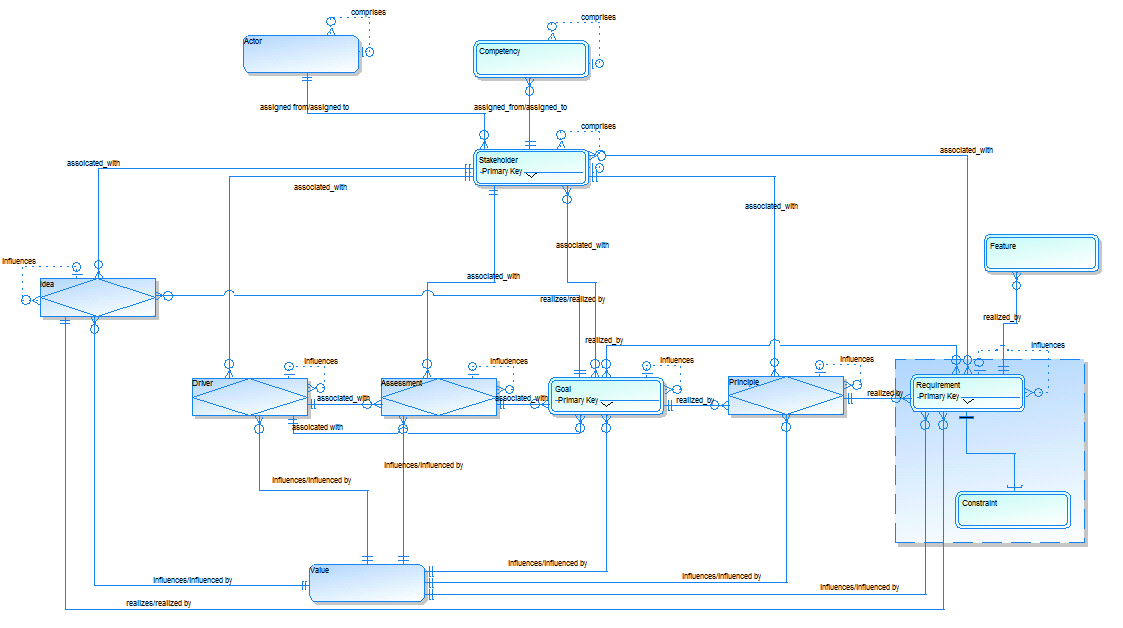
Some of the objects and metamodel are based on the ArchiMate specification from the Open Group. However, this has been significantly extended to support innovation management.
erwin licenses the ArchiMate specification from the open group. The terms of the license are here.
Enterprise architecture metamodel
Enterprise architecture metamodel
Package: Agile Enterprise Architecture
Role Applicable to: Client Administrator, User, Contributor, Reviewer
The enterprise architecture metamodel is based on ArchiMate and TOGAF 9 attributes. The metamodel includes the following:
ArchiMate 2.1 Core
ArchiMate 2.1 Implementation and Migration Extension
ArchiMate 2.1 Motivation Extension
Capability Extension
The metamodel has been extended from ArchiMate 2.1 to reflect the Open Groups' latest thinking around capabilities. A working whitepaper is available through the open group.
Attributes
The ArchiMate language does not define any explicit attributes for object types. Therefore, all attributes for the metamodel are mapped from TOGAF 9.1 attributes. Where object types are specializations of other other types, then we have mapped the super type attributes to the sub type. For example, a Metric will inherit all of the attributes of Driver as it is a specialism of a Driver.
The platform is extensible and you may add your own attributes to any object type. See the customization section for more details.
A link to the specification exists here.
The mappings are based on the harmonization work carried out at the open group between TOGAF and ArchiMate. The link to this work is here. However, you must be an Open Group member to access these documents.
The following table shows the ArchiMate to TOGAF object type mappings and the attributes that have been mapped:
Business Domain Metamodel
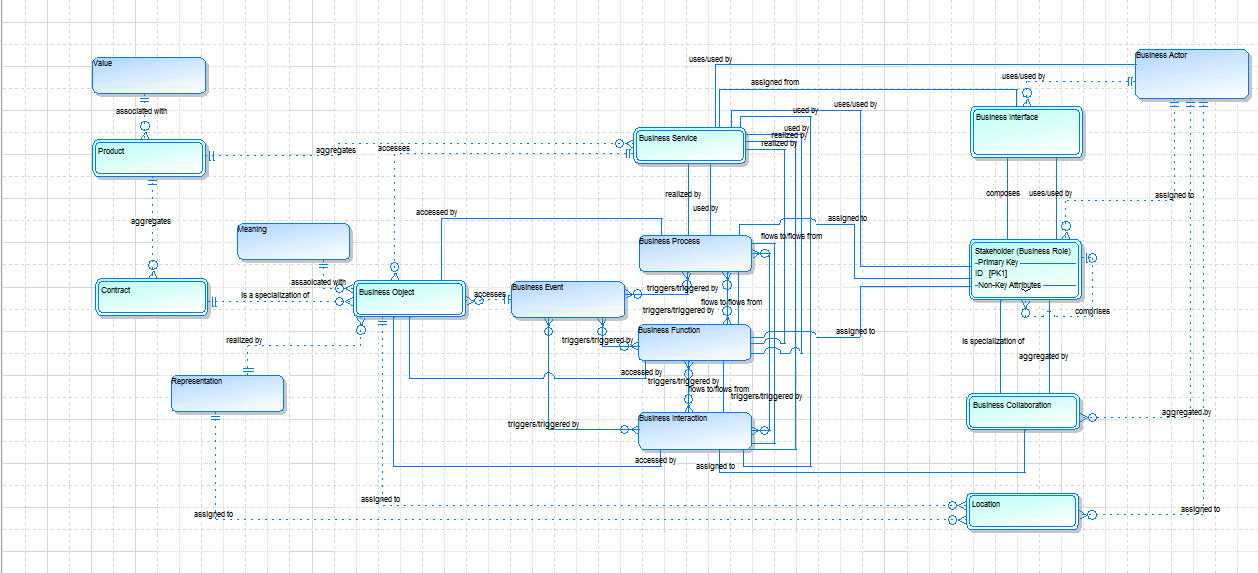
|
ArchiMate Element |
TOGAF Element |
Attributes |
|
Business Actor |
Actor |
|
# FTEs |
Estimated number of FTEs that operate as this Actor. |
|
Actor goal |
Objectives that this actor has, in general terms. |
|
Actor tasks |
Tasks that this actor performs, in general terms. | |
|
|
Organization Unit |
|
Headcount |
Number of FTEs working within the organization. (Note that this attribute is merged with # FTEs) | |
|
Business Collaboration |
N/A |
This object type has the default description attribute. |
|
Business Function |
Function |
|
Standard Class |
Non-Standard, Proposed Standard, Provisional Standard, Standard, Phasing-Out Standard, RetiredStandard |
|
Standard creation date |
If the product is a standard, when the standard was created. |
|
Last standard review date |
Last date that the standard was reviewed. |
|
Next standard review date |
Next date for the standard to be reviewed. |
|
Retire date |
Date when the standard was/will be retired. | |
|
Business Interface |
N/A |
This object type has the default description attribute. |
|
Business Object |
Data Entity |
|
Category |
The following categories of data entity apply: Message, Internally Stored Entity. |
|
Privacy classification |
Level of restriction placed on access to the data. |
|
Retention classification |
Level of retention to be placed on the data. | |
|
Business Process |
Process |
|
Standards class |
Non-Standard, Proposed Standard, Provisional Standard, Standard, Phasing-Out Standard, Retired Standard |
|
Standard creation date |
If the product is a standard when the standard was created. |
|
Last standard review date |
Last date that the standard was reviewed. |
|
Next standard review date |
Next date for the standard to be reviewed. |
|
Retire date |
Date when the standard was/will be retired. |
|
Process criticality |
Criticality of this process to business operations. |
|
Manual or automated |
Whether this process is supported by IT or is a manual process. |
|
Process volumetrics |
Data on frequency of process execution. | |
|
Role |
Role |
|
# FTEs |
Estimated number of FTEs that operate as this Role. | |
|
Business Service |
Service |
|
Standards class |
Non-Standard, Proposed Standard, Provisional Standard, Standard, Phasing-Out Standard, Retired Standard |
|
Standard creation date |
If the product is a standard when the standard was created. |
|
Last standard review date |
Last date that the standard was reviewed. |
|
Next standard review date |
Next date for the standard to be reviewed. |
|
Retire Date |
Date when the standard was/will be re | |
|
Contract |
Contract |
|
Behavior characteristics |
Functional behavior to be supported within the scope of the contract. |
|
Service name "caller" |
Consuming service. |
|
Service name "called" |
Providing service. |
|
Service quality characteristics |
Non-functional behavior to be supported within the scope of the contract. |
|
Availability characteristics |
Degree to which something is available for use |
|
Service times |
Hours during which the service must be available |
|
Manageability characteristics |
Ability to gather information about the state of something and control it |
|
Serviceability characteristics |
Ability to identify problems and take corrective action, such as to repair or upgrade a component in a running system |
|
Performance characteristics |
Ability of a component to perform its tasks in an appropriate time. |
|
Response requirement |
Response times that the service provider must meet for particular operations. |
|
Reliability characteristics |
Resistance to failure. |
|
Quality of information required |
Contracted requirements on accuracy and completeness of information |
|
Contract control requirements |
Level of governance and enforcement applied to the contractual parameters for overall service. |
|
Result control requirements |
Measures in place to ensure that each service request meets contracted criteria |
|
Recoverability characteristics |
Ability to restore a system to a working state after an interruption |
|
Locatability characteristics |
Ability of a system to be found when needed |
|
Security characteristics |
Ability of a system to prevent unauthorized access to functions and data |
|
Privacy characteristics |
Protection of data from unauthorized access |
|
Integrity characteristics |
Ability of a system to ensure that data has not been corrupted |
|
Credibility characteristics |
Ability of a system to ensure that the service request originates from an authorized source |
|
Localization characteristics |
Ability of a service to support localized variants for different consumer groups |
|
Internationalization characteristics |
Ability of a service to support international variations in business logic and data representation (such as character set) |
|
Interoperability characteristics |
Ability of the service to interoperate with different technical environments, inside and outside of the organization. |
|
Scalability characteristics |
Ability of the service to grow or shrink its performance or capacity appropriately to the demands of the environment in which it operates |
|
Portability characteristics |
Of data, people, applications, and components. |
|
Extensibility characteristics |
Ability to accept new functionality. |
|
Capacity characteristics |
Contracted capacity of the service provider to meet requests |
|
Throughput |
Required throughput capacity. |
|
Throughput period |
Time period needed to deliver throughput capacity |
|
Growth period |
Expected future growth rate of service request |
|
Peak profile short term |
Short-term profile of peak service traffic |
|
Peak profile long term |
Long-term profile of peak service traffic | |
|
Business Event |
Event |
This object type has the default description attribute. |
|
Business Interaction |
Process or Function |
|
Standards class |
Non-Standard, Proposed Standard, Provisional Standard, Standard, Phasing-Out Standard, Retired Standard |
|
Standard creation date |
If the product is a standard when the standard was created. |
|
Last standard review date |
Last date that the standard was reviewed. |
|
Next standard review date |
Next date for the standard to be reviewed. |
|
Retire Date |
Date when the standard was/will be retired, | |
|
Location |
Location |
|
Category |
The following categories of Location apply: Region (applies to a grouping of countries or territory, e.g., South East Asia, UK, and Ireland), Country (applies to a single country; e.g., US), Building (applies to a site of operation; where several offices are collected in a single city, this category may represent a city), and Specific Location (applies to any specific location within a building, such as a server room). The nature of the business may introduce other Locations: Ship or Port for a ferry company, Mine for a gold company, Car for a police force, Hotel for any firm's traveling workers, and so on. | |
|
Meaning |
N/A |
This Object type has the default description attribute. |
|
Product |
Product |
This Object type has the default description attribute. |
|
Representation |
N/A |
This Object type has the default description attribute. |
|
Value |
N/A |
This Object type has the default description attribute. |
Application Domain Metamodel
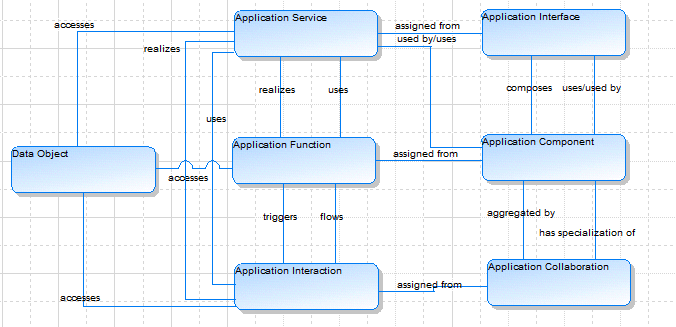
|
ArchiMate Element |
TOGAF Element |
Attributes |
|
Application Service |
Information System Service |
|
Standards class |
Non-Standard, Proposed Standard, Provisional Standard, Standard, Phasing-Out Standard, Retired Standard |
|
Standard creation date |
If the product is a standard when the standard was created. |
|
Last standard review date |
Last date that the standard was reviewed. |
|
Next standard review date |
Next date for the standard to be reviewed. |
|
Retire Date |
Date when the standard was/will be retired, | |
|
Data Object |
Data Entity |
|
Category |
The following categories of data entity apply: Message, Internally Stored Entity |
|
Privacy classification |
Level of restriction placed on access to the data |
|
Retention classification |
Level of retention to be placed on the data | |
|
|
Logical Data Component |
|
Standards class |
Non-Standard, Proposed Standard, Provisional Standard, Standard, Phasing-Out Standard, Retired Standard |
|
Standard creation date |
If the product is a standard when the standard was created. |
|
Last standard review date |
Last date that the standard was reviewed. |
|
Next standard review date |
Next date for the standard to be reviewed. |
|
Retire Date |
Date when the standard was/will be retired, | |
|
Application Interface |
N/A |
This Object type has the default description attribute. |
|
Application Component |
Logical Application Component |
|
Standards class |
Non-Standard, Proposed Standard, Provisional Standard, Standard, Phasing-Out Standard, Retired Standard |
|
Standard creation date |
If the product is a standard when the standard was created. |
|
Last standard review date |
Last date that the standard was reviewed. |
|
Next standard review date |
Next date for the standard to be reviewed. |
|
Retire Date |
Date when the standard was/will be retired, | |
|
|
Physical Application Component |
|
Lifecycle status |
Proposed, In Development, Live, Phasing Out, Retired |
|
Standards class |
Non-Standard, Proposed Standard, Provisional Standard, Standard, Phasing-Out Standard, Retired Standard |
|
Standard creation date |
If the product is a standard, when the standard was created |
|
Last standard review date |
Last date that the standard was reviewed |
|
Next standard review date |
Next date for the standard to be reviewed |
|
Retire date |
Date when the standard was/will be retired |
|
Initial live date |
Date when the first release of the application was/will be released into production |
|
Date of last release |
Date when the last release of the application was released into production |
|
Date of next release |
Date when the next release of the applic.ation will be released into production |
|
Retirement date |
Date when the application was/will be retired |
|
Availability characteristics |
Degree to which something is available for use. |
|
Service times |
Hours during which the application must be available |
|
Manageability characteristics |
Ability to gather information about the state of something and control it |
|
Serviceability characteristics |
Ability to identify problems and take corrective action, such as to repair or upgrade a component in a running system |
|
Performance characteristics |
Ability of a component to perform its tasks in an appropriate time |
|
Reliability characteristics |
Resistance to failure |
|
Recoverability characteristics |
Ability to restore a system to a working state after an interruption |
|
Locatability characteristics |
Ability of a system to be found when needed |
|
Security characteristics |
Ability of a system to prevent unauthorized access to functions and data |
|
Privacy characteristics |
Protection of data from unauthorized access |
|
Integrity characteristics |
Ability of a system to ensure that data has not been corrupted |
|
Credibility characteristics |
Ability of a system to ensure that the service request originates from an authorized source |
|
Localization characteristics |
Ability of a service to support localized variants for different consumer groups |
|
Internationalization characteristics |
Ability of a service to support international variations in business logic and data representation (such as character set) |
|
Interoperability characteristics |
Ability of the service to interoperate with different technical environments, inside and outside of the organization |
|
Scalability characteristics |
Ability of the service to grow or shrink its performance or capacity appropriately to the demands of the environment in which it operates |
|
Portability characteristics |
Of data, people, applications, and components |
|
Extensibility characteristics |
Ability to accept new functionality |
|
Capacity characteristics |
Contracted capacity of the service provider to meet requests |
|
Throughput |
Required throughput capacity |
|
Throughput period |
Time period needed to deliver throughput capacity |
|
Growth |
Expected future growth rate of service request |
|
Growth period |
Time period needed to reach the expected growth rate |
|
Peak profile short term |
Short-term profile of peak service traffic |
|
Peak profile long term |
Long-term profile of peak service traffic | |
|
Application Collaboration |
N/A |
This Object type has the default description attribute. |
|
Application Function |
Logical Application Component |
|
Standards class |
Non-Standard, Proposed Standard, Provisional Standard, Standard, Phasing-Out Standard, Retired Standard |
|
Standard creation date |
If the product is a standard when the standard was created. |
|
Last standard review date |
Last date that the standard was reviewed. |
|
Next standard review date |
Next date for the standard to be reviewed. |
|
Retire Date |
Date when the standard was/will be retired, | |
Technology Domain Metamodel
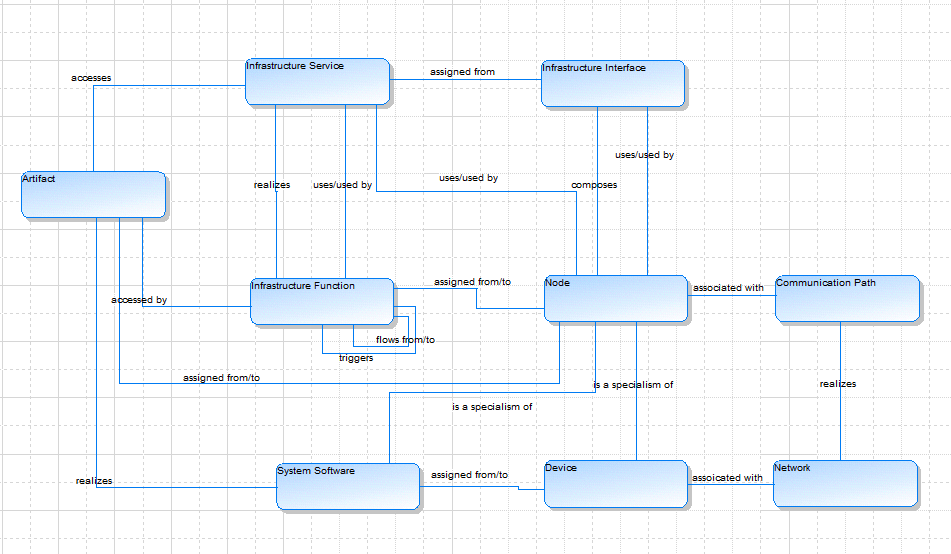
|
ArchiMate Element |
TOGAF Element |
Attributes |
|
Infrastructure Service |
Platform Service |
|
Standard Class |
Non-Standard, Proposed Standard, Provisional Standard, Standard, Phasing-Out Standard, Retired Standard. |
|
Category |
Platform Services are categorized according to the TOGAF TRM, which may be extended to meet the needs of an individual organization | |
|
Infrastructure Function |
Logical Technology Component |
|
Standards class |
Non-Standard, Proposed Standard, Provisional Standard, Standard, Phasing-Out Standard, Retired Standard |
|
Standard creation date |
If the product is a standard when the standard was created. |
|
Last standard review date |
Last date that the standard was reviewed. |
|
Next standard review date |
Next date for the standard to be reviewed. |
|
Retire Date |
Date when the standard was/will be retired, | |
|
Artifact |
Physical Data Component |
|
Standards class |
Non-Standard, Proposed Standard, Provisional Standard, Standard, Phasing-Out Standard, Retired Standard |
|
Standard creation date |
If the product is a standard when the standard was created. |
|
Last standard review date |
Last date that the standard was reviewed. |
|
Next standard review date |
Next date for the standard to be reviewed. |
|
Retire Date |
Date when the standard was/will be retired, | |
|
System Software |
Physical Technology Component |
|
Standards class |
Non-Standard, Proposed Standard, Provisional Standard, Standard, Phasing-Out Standard, Retired Standard |
|
Standard creation date |
If the product is a standard when the standard was created. |
|
Last standard review date |
Last date that the standard was reviewed. |
|
Next standard review date |
Next date for the standard to be reviewed. |
|
Retire Date |
Date when the standard was/will be retired, |
|
Category |
Physical Technology Components are categorized according to the TOGAF TRM, which may be extended to meet the needs of an individual organization. |
|
Product Name |
Name of the product making up the technology component. |
|
Module Name |
Module, or other sub-product, name making up the technology component. |
|
Vendor |
Vendor providing the technology component. |
|
Version |
Version of the product making up the technology component | |
|
Device |
Physical Technology Component |
|
Standards class |
Non-Standard, Proposed Standard, Provisional Standard, Standard, Phasing-Out Standard, Retired Standard |
|
Standard creation date |
If the product is a standard when the standard was created. |
|
Last standard review date |
Last date that the standard was reviewed. |
|
Next standard review date |
Next date for the standard to be reviewed. |
|
Retire Date |
Date when the standard was/will be retired, | |
|
Node |
Logical Technology Component |
|
Standards class |
Non-Standard, Proposed Standard, Provisional Standard, Standard, Phasing-Out Standard, Retired Standard |
|
Standard creation date |
If the product is a standard when the standard was created. |
|
Last standard review date |
Last date that the standard was reviewed. |
|
Next standard review date |
Next date for the standard to be reviewed. |
|
Retire Date |
Date when the standard was/will be retired, | |
|
Infrastructure Interface |
Logical Technology Component |
|
Standards class |
Non-Standard, Proposed Standard, Provisional Standard, Standard, Phasing-Out Standard, Retired Standard |
|
Standard creation date |
If the product is a standard when the standard was created. |
|
Last standard review date |
Last date that the standard was reviewed. |
|
Next standard review date |
Next date for the standard to be reviewed. |
|
Retire Date |
Date when the standard was/will be retired, | |
|
|
Physical Technology Component |
|
Standards class |
Non-Standard, Proposed Standard, Provisional Standard, Standard, Phasing-Out Standard, Retired Standard |
|
Standard creation date |
If the product is a standard when the standard was created. |
|
Last standard review date |
Last date that the standard was reviewed. |
|
Next standard review date |
Next date for the standard to be reviewed. |
|
Retire Date |
Date when the standard was/will be retired, |
|
Category |
Physical Technology Components are categorized according to the TOGAF TRM, which may be extended to meet the needs of an individual organization. |
|
Product Name |
Name of the product making up the technology component. |
|
Module Name |
Module, or other sub-product, name making up the technology component. |
|
Vendor |
Vendor providing the technology component. |
|
Version |
Version of the product making up the technology component | |
|
Network |
Physical Technology Component |
|
Standards class |
Non-Standard, Proposed Standard, Provisional Standard, Standard, Phasing-Out Standard, Retired Standard |
|
Standard creation date |
If the product is a standard when the standard was created. |
|
Last standard review date |
Last date that the standard was reviewed. |
|
Next standard review date |
Next date for the standard to be reviewed. |
|
Retire Date |
Date when the standard was/will be retired, |
|
Category |
Physical Technology Components are categorized according to the TOGAF TRM, which may be extended to meet the needs of an individual organization. |
|
Product Name |
Name of the product making up the technology component. |
|
Module Name |
Module, or other sub-product, name making up the technology component. |
|
Vendor |
Vendor providing the technology component. |
|
Version |
Version of the product making up the technology component | |
|
Communication Path |
Logical Technology Component |
|
Standards class |
Non-Standard, Proposed Standard, Provisional Standard, Standard, Phasing-Out Standard, Retired Standard |
|
Standard creation date |
If the product is a standard when the standard was created. |
|
Last standard review date |
Last date that the standard was reviewed. |
|
Next standard review date |
Next date for the standard to be reviewed. |
|
Retire Date |
Date when the standard was/will be retired, | |
Cross Layer Metamodel
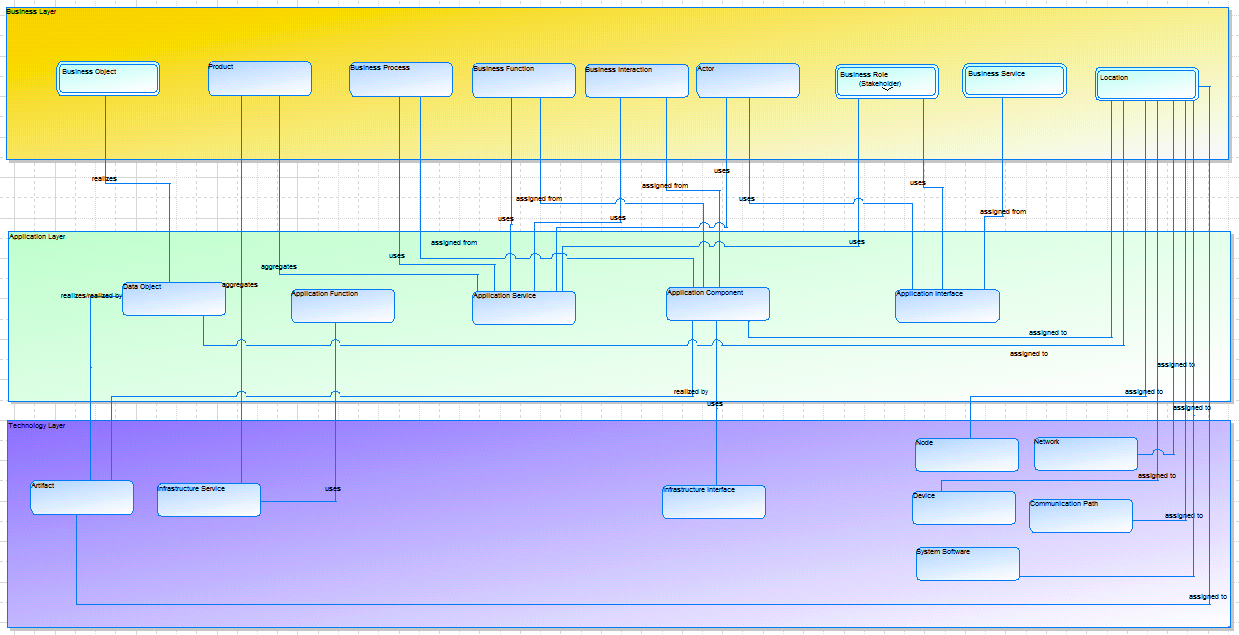
Implementation and Migration Extension Metamodel
|
Plateau |
N/A |
This object type has the default description attribute. |
|
Gap |
Gap |
This object type has the default description attribute. |
|
Deliverable |
N/A |
This object type has the default description attribute. |
|
Work Package |
Work Package |
|
Category |
The following categories of work package apply: Work Package, Work Stream, Project, Program, Portfolio. |
|
Capability delivered |
Describes the contribution this work package makes to capability delivery. | |
Motivation Extension Metamodel
|
Stakeholder (specialism of Role) |
Role |
|
# FTEs |
Estimated number of FTEs that operate as this Role | |
|
|
Organization Unit |
|
Headcount |
Number of FTEs working within the organization. (Note that this attribute is merged with # FTEs) | |
|
Driver |
Driver |
This object type has the default description attribute. |
|
Assessment |
Measure |
This object type has the default description attribute. |
|
Goal |
Goal |
This object type has the default description attribute. |
|
|
Objective |
This object type has the default description attribute. |
|
Principle |
Principle |
|
Category |
The following categories of principle apply: Guiding Principle, Business Principle, Data Principle, Application Principle, Integration Principle, Technology Principle. |
|
Priority |
Priority of this principle relative to other principles |
|
Statement of Principle |
Statement of what the principle is |
|
Rationale |
Statement of why the principle is required and the outcome to be reached |
|
Implication |
Statement of what the principle means in practical terms |
|
Metric |
Identifies mechanisms that will be used to measure whether the principle has been met or not | |
|
Requirement |
Requirement |
|
Statement of requirement |
Statement of what the requirement is, including a definition of whether the requirement shall be met, should be met, or may be met |
|
Rationale |
Statement of why the requirement exists |
|
Acceptance criteria |
Statement of what tests will be carried out to ensure that the requirement will be met | |
|
Constraint |
Constraint |
This object type has the default description attribute. |
Capability Based Planning
|
Business Capability |
Capability |
|
Business Value |
Describes how this capability provides value to the enterprise |
|
Increments |
Lists possible maturity/quality levels for the capability | |
|
Capability Increment |
N/A |
This object type has the default description attribute. |
|
Metric |
N/A |
This object type has the default description attribute. |
Enterprise architecture notation
Enterprise architecture notation
Package: Agile Enterprise Architecture
Role Applicable to: Client Administrator, User, Contributor, Reviewer
The agile enterprise architecture notation uses the standard ArchiMate 2.1 notation.
Corso supply a poster of the ArchiMate notation that you may find useful.
Business Layer

Application Layer
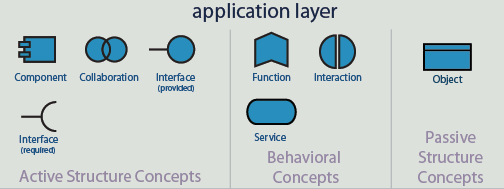
Technology Layer
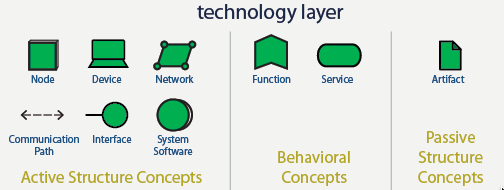
Motivation Extension
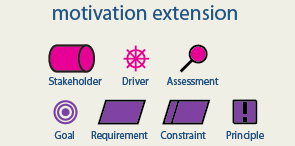
Implementation and Migration Extension
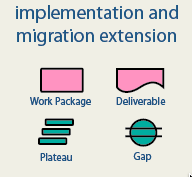
Capability Extension

Relationship types
